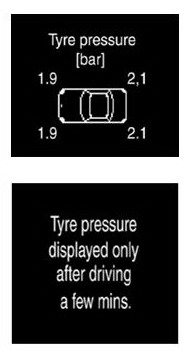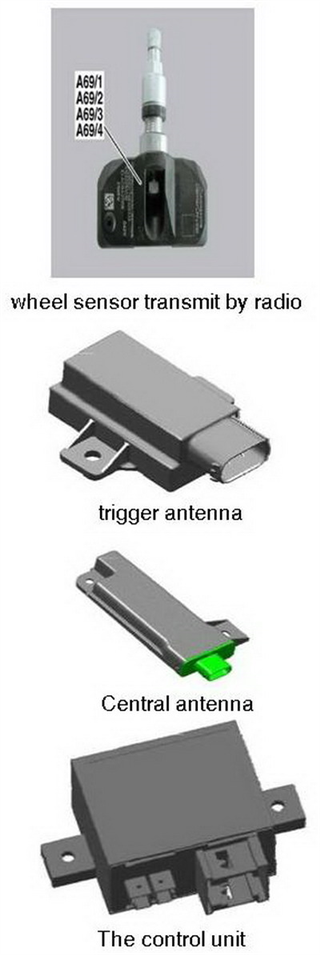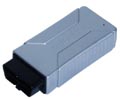- Benz 216 Tire Pressure
- |
- Benz 216 control Units
- |
- Mercedes Electronic
- |
- Technical Info
- |
- Car Tech Info
- |
- MicroTronik
Mercedes Benz 216 Tire Pressure Monitor Control Unit

display messages

operating/display concept
TPM (Tire Pressure Monitor)
Basic function
The TPM system constantly monitors the tire inflation pressure.Basic function
For this purpose the tire inflation pressure and temperature are measured in the tire at certain intervals and are transmitted telemetrically over a HF link to the TPM control unit.
The control unit evaluates the data received and forwards the information to the instrument cluster.
The multifunction display in the instrument cluster notifies the driver of the current tire inflation pressure or of any necessary corrections to the tire pressure, and alerts him to punctures.
Note:
The components from the two system suppliers (Beru/Siemens) are not compatible with each other!
This is particularly important when using complete wheel/tire assemblies with wheel sensors from a different vehicle.
If incorrect makes are installed or mixed, proper functioning of the system can no longer be guaranteed.
Modifications/new features
· System functionsRevised warning algorithm for triggering a warning
- Soft warning
- Hard warning
- Rapid pressure loss
· Inflation detection
The TPM control unit automatically detects a new pressure setting whenever a pressure change of more than 0.2 bar is made at least 2 wheels.
After the vehicle starts to move, the new pressure readings are checked for compliance with the minimum pressure and for plausibility - if they are OK, the nominal values and warning thresholds are adjusted accordingly.
· Manual activation
The driver can still perform manual activation via the menu. This informs the control unit that the current pressure settings are to be regarded as nominal values.
Any active warning messages are canceled and the TPM warning lamp goes out. After the vehicle starts to move, the new pressure readings are checked for compliance with the minimum pressure and for plausibility - if they are OK, the nominal values and warning thresholds are adjusted accordingly.
TPM displays (display messages) Revised wording, e.g.:
Status screen after ignition restart (If the wheels are known, the pressure screen appears shortly after the car starts to move (> 25 km/h); if the wheels are unknown, it can take slightly longer)
Components
1. 4 wheel sensors transmit by radio:ID; absolute pressure; temperature of the sensor, radial acceleration (the acceleration depends on the rotational speed of the wheel)
The transmission frequency of the wheel electronics unit depends on the vehicle speed and on the pressure, i.e. in simplified terms:
Stationary - wheel electronics unit not transmitting Driving - (>25 km/h):
three sequential logs once per minute.
Pressure change Driving condition: >= 0.2 bar, 3 signals sent at 15 sec intervals after 15 sec.
Parking: >= 0.2 bar, 2 signals sent at 20 sec intervals after 30 sec at the latest.
2. 2 trigger antennas at the front
The antennas serve solely to identify the positions of the front wheels (rear wheels on model 164).
The trigger pulse is transmitted on request from the control unit.
3. The positions of the rear wheels
can only be recognized when the vehicle is cornering based on the steering angle and the different wheel rotational speeds.
4. Central antenna
The signals are received by the central antenna and forwarded to the control unit over a discrete line.
5. The control unit
continues to operate for 20 min after the journey, then it shuts itself down.
The control unit wakes up when the CAN-B is woken and is ready to operate at “Ignition ON”, when messages are transmitted to the instrument cluster.
The system can issue a variety of warnings (Soft or Hard).
The warnings are output with different priorities.
Main modifications (operating/display concept)
Automatic detection of manual pressure changes To No manual reactivation of the system necessaryAutomatic detection of missing wheel electronics units (e.g. winter wheels) To Automatic system shutdown
Warnings with pressure display
Note:
• Due to the different systems and the diversity of display messages (system errors/ warnings and instructions), it is all the more important that these be correctly interpreted so that unnecessary diagnostic work is avoided.
e.g. the message (Tire Pressure Monitor currently unavailable)
Message is due to:
- Interference
- Overvoltage/undervoltage
No defect - no repair necessary
System errors are recorded with fault entries, which must always be processed in accordance with the fault tree.
Please note that actual values may only be used for diagnosis when this is explicitly permitted.
AutoHex (Auto Diagnostic scanner) is one of the best Professional scan tools to for Mercedes Benz; Autohex Scanner can test Mercedes Benz Systems effectively and easily, with many powerful features to help you in diagnosing and testing. For more information:
Mercedes Benz Scan Tool
Changing Dmaged DME in F Series
Description
In this section we add some useful information about some Mercedes Benz 216 Tire Pressure Monitor Systems and it features.
Autohex II Reviews
AutoHex II
AutoHex II is your best choice to have full access to dealer functions like coding, adjusting and modules flashing/programming, Contact us for prices
AutoHex Forum
In AutoHex onboard diagnostic forum you will find discussions how to change the configurations of the car by the professional special functions using AutoHex scan tool
Car Technical Information
To test a car you need a professional and technical information, the more information you have, the more easy you can find the fault
Diagnosis and Coding
_simageid_319.jpg)





